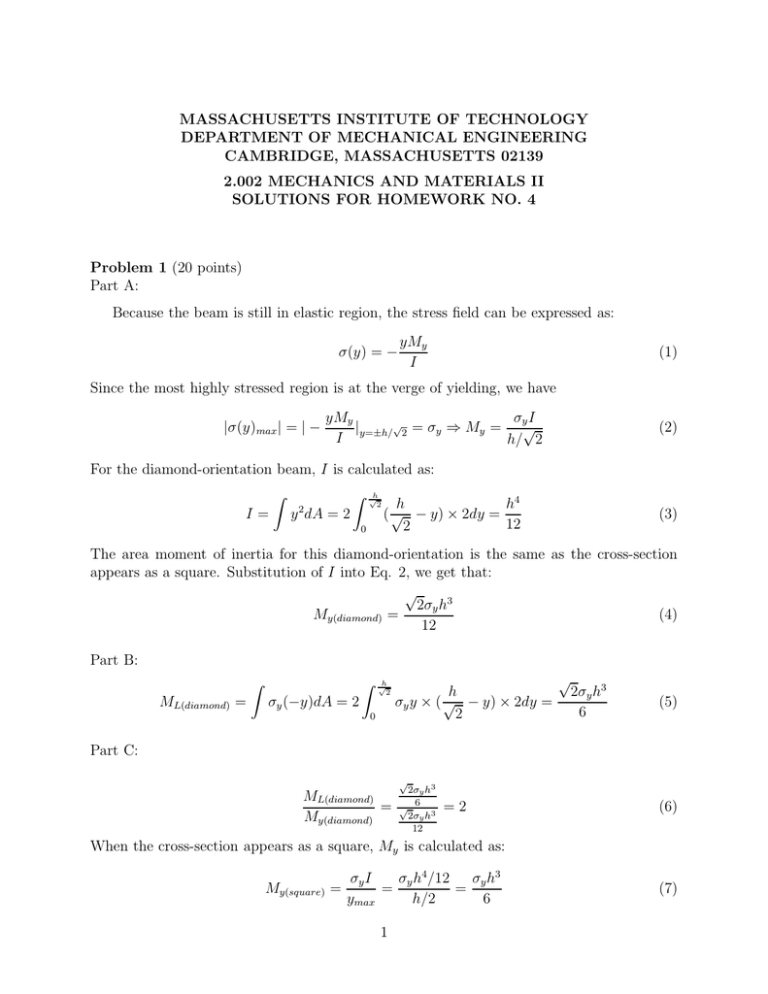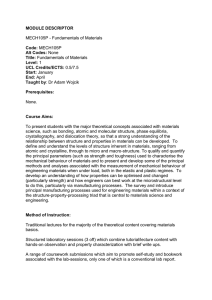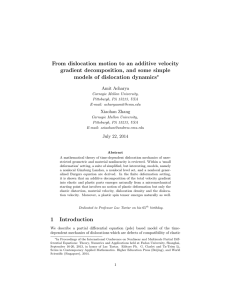MASSACHUSETTS INSTITUTE OF TECHNOLOGY
advertisement

MASSACHUSETTS INSTITUTE OF TECHNOLOGY
DEPARTMENT OF MECHANICAL ENGINEERING
CAMBRIDGE, MASSACHUSETTS 02139
2.002 MECHANICS AND MATERIALS II
SOLUTIONS FOR HOMEWORK NO. 4
Problem 1 (20 points)
Part A:
Because the beam is still in elastic region, the stress field can be expressed as:
σ(y) = −
yMy
I
(1)
Since the most highly stressed region is at the verge of yielding, we have
|σ(y)max | = | −
yMy
σy I
|y=±h/√2 = σy ⇒ My = √
I
h/ 2
(2)
For the diamond-orientation beam, I is calculated as:
�
I=
2
�
√h
y dA = 2
2
0
h4
h
( √ − y) × 2dy =
12
2
(3)
The area moment of inertia for this diamond-orientation is the same as the cross-section
appears as a square. Substitution of I into Eq. 2, we get that:
√
2σy h3
(4)
My(diamond) =
12
Part B:
�
ML(diamond) =
�
σy (−y)dA = 2
h
√
2
0
h
σy y × ( √ − y) × 2dy =
2
√
2σy h3
6
(5)
Part C:
√
ML(diamond)
=
My(diamond)
2σy h3
6
√
2σy h3
12
=2
(6)
When the cross-section appears as a square, My is calculated as:
My(square)
σy h3
σy I
σy h4 /12
=
=
=
ymax
h/2
6
1
(7)
and ML is:
�
ML(square) =
�
σ(−y)dA = 2
h
2
0
σy y × hdy =
σy h3
4
(8)
So the ratio of ML /My for square-orientation is:
ML(square)
=
My(square)
σy h3
4
σy h3
6
=
3
2
(9)
Part D:
The ratio of the first-yield bending moments for the two orientations is:
√
2σy h3
12
σy h3
6
My(diamond)
=
My(square)
√
= 1/ 2
(10)
The first-yield bending moment is calculated by:
My =
σy I
ymax
(11)
Since σy is a constant, and I is the same for these two orientations, the above ratio is only
determined by the ratio of ymax . The ratio of limit moment for the two orientations is:
ML(diamond)
=
ML(square)
√
2σy h3
6
σy h3
4
=
2√
2 < 1.0
3
The limit moment for a symmetrical cross-section is calculated by:
�
ydA
ML = 2σy
(12)
(13)
A/2
where A/2 is the 1/2 area of the cross
√ section in which y ≥ 0. For the diamond-orientation,
though the maximum value of y is 2 times larger than the square-orientation, the major
part of its cross-section is located at the region with small y coordinate. Thus the ratio of
limit moment calculated above is smaller than one.
Since My(diamond) < My(square) and ML(diamond) < ML(square) , we should use the beam in
the square-orientation.
Part E:
The unloaded stress field is expressed as:
σunloaded = σloaded + ∆σ(y)
(14)
With the assumption of elastic unloading from the limit condition ML , ∆σ(y) can be expressed as following:
yML(diamond)
−y∆M
=
(15)
∆σ(y) =
I
I
2
Substitution of ∆σ(y) , I and ML(diamond) into Eq. 14, we find that:
√
−σy +√
2 2σy (y/h) if y ≥ 0;
σunloaded = {
if y < 0.
σy + 2 2σy (y/h)
(16)
Similarly, the unloaded stress field for the square-orientation is expressed as:
σunloaded = σloaded +
yML(square)
−σy + 3σy (y/h) if y ≥ 0;
={
σy + 3σy (y/h)
if y < 0.
I
(17)
The stress field is shown in Figure 1.
For the diamond-orientation, since the residual stress at y = ymax is σy , no negative
moment (which will cause positive stress increment to the upper part and negative increment
of stress for the lower part) can be applied without further plasticity.
3
(a) diamond-orientation
(b) square-orientation
Figure 1 Unloaded stress
Problem 2 (30 points)
There are 4 basic ways to strengthen metallic crystalline materials. All 5 mechanisms
impede dislocation motion by creating an impedance to dislocation motion which raises the
shear stress required for dislocation motion. Three of the mechanisms involve objects that
get in the way of dislocation motion. In those mechanisms, the shear strength has the general
relation τ = Gb
where L is some characteristic length between objects.
L
1. One mechanism is obstacle/precipitate strengthening. The shear stress required for
a dislocation to loop around an obstacle or second phase precipitate in the matrix
is a function of the precipitate spacing or diameter L0 is precipitate spacing, D0 is
precipitate diameter, c0 is alloy concentration:
τ=
(
Gb
L0
D0 3
) ∼ c0
L0
1/3
Gbc0
τ =
D0
So, smaller diameters increase the shear stress required for dislocation motion, thus
“smaller diameters are stronger.” This is valid down to the diameter where the dislocation begins to cut through the particle, at which point the shear stress begins to
decrease with diameter.
2. A second strengthening mechanism is solid solution strengthening (SSS). In SSS, alloying atoms fill either substitutional positions or interstitial positions in the lattice.
In a solid solution of concentration c0 , the spacing of dissolved atoms on the slip plane
−1/2
1/2
L varies as c0 . Since, τ = Gb
, we have τ ∝ c0 . So, the greater the concentration
L
the ‘rougher’ the slip plane, which reveals “Smaller defect spacing is stronger.”
3. A third strengthening mechanism is strain hardening. When dislocations meet each
other during plastic deformation they impede each other and also multiply. More
plastic strain means more dislocations are created. Because a large shear stress is
required to have one dislocation pass through another, a higher dislocation density
means the shear stress required for dislocation motion should be higher. Thus if dislocation density is higher, the space between dislocations is smaller. Therefore having
“smaller spaces between dislocations is stronger.” Mathematically, this is seen by the
dislocation density, ρ.
Ld
ρ=
V
where Ld
is the dislocation line length in a given volume and V is the volume. The
√
spacing between dislocations can be thought of as Lds = 1/ ρ . Thus the distance
√
= Gb ρ
between other dislocations is Lds and τ = LGb
ds
4
4. A final strengthening mechanism fitting into the ”smaller is stronger” category is grain
size strengthening. Single crystalline grains are randomly aligned and misoriented
with each other. Thus, at a boundary, the dislocation has a problem entering the next
grain. The smaller the grain size, the more boundaries exist, therefore creating high
impedance to dislocation motion. Again,“smaller grain size is stronger.” The relation
between grain size and strength is known as the Hall-Petch relation, σy = σ0 + Kd1/2
5
Problem 3 (30 points)
PART A: The elastic strain is not important because we are talking about a very large
deformation (H/H0 = 0.5 σy /E) Almost all of this deformation takes place in the plastic
regime. This can be seen numerically. Because deformations are so large, true stress true
strain must be used.
total = ln(1 + eng ) = ln(1 +
elastic =
H
− 1) = −0.69
H0
−σy
= −0.0025
E
|elastic |
1.0 ⇒ total ∼ plastic
|total |
(18)
(19)
(20)
You can see the percentage of total strain in the elastic region is only 0.3%.
Part B: Considering now only analysis in the plastic regime, note the following relationship
between the material strength, s and the absolute value of plastic strain, ¯p , is given to be
linear:
ds
=h
(21)
d¯p
Integrating that from ¯p = 0 gives:
s(¯
p ) = s0 + h¯p
(22)
s0 is the stress at the beginning of plastic deformation. Because the loading is monotonic,
once yielding begins the following relationship is true (σ is negative in compression)
s = σ¯ = |σ| = −σ
(23)
Also realize that in compression, axial strain is negative:
¯p = −p
(24)
From part a) it was determined that ≈ p Therefore we have
−σ = s0 − h
σ = −s0 + h
Denote the condition where H/H0 = 0.5, = −0.69 with a subscript c.
σc = −s0 + hc ⇒ σc = −500 + 2000 × (−0.69) = −1886MP a
(25)
Thus σ must equal σc when the desired deformation is achieved. The question asks for
largest diameter that can be safely used in the machine for this specific test. We have the
6
constraint that σ = σc . The machine has a load capacity of −100[kN], which means that
|P | ≤ 100kN. For uniaxial compression,
P
A
σ=
(26)
Where P is the axial load and A is the cross sectional area.
|P | = |σc A| ≤ 100[kN] ⇒ σc A ≥ −100[kN]
(27)
Realizing that area changes under plastic deformations and then realizing that the governing
principle for area change under plastic deformation is volume conservation, we have:
A = A0
H
= 2A0
H0
So now we have:
2σc A0 ≥ −100[kN] ⇒ A0 ≤
Rewrite in terms of the diameter
A0 =
�
we have:
d≤
4 × 100[kN]
=
−2πσc
�
(28)
100[kN]
−2σc
πd2
,
4
4 × 100[kN]
= 5.8[mm]
−2π(−1.886E 6 [kP a])
(29)
(30)
(31)
Thus, the maximum diameter we can choose that will still be safe and give the dis- placement
needed is d = 5.8[mm].
7
Problem 4 (20 points)
Part A:
Pmax
1.1[MN ]
=
= 440[MP a] > 350[MP a]
A
25[mm] × 100[mm]
(32)
The as-received bar can not support the Pmax . The maximum load it can support without
plastic deformation is:
Pelastic = σy × A = 350[
N
] × 25[mm] × 100[mm] = 0.875MN
mm2
(33)
Part B:
Under plastic deformation, there is no volume change:
k=3
�
dpkk = 0
(34)
k=1
We know that dp33 = 0, thus we have:
(p)
(p)
(p)
(p)
d11 + d22 = 0 ⇒ d11 = −d22 = −
(p)
dt
t
(35)
(p)
Substitution of d11 and d22 into the equation for the equivalent plastic strain increment,
we have:
�
�
� 3 3
� 2 � � (p) (p)
2
2 |dt|
(p)
(p)
p
((d11 )2 + (d22 )2 ) = √
(36)
dij dij =
d¯ = �
3 i=1 j=1
3
3 t
Because dt < 0, the above equation can be rewritten as:
2 dt
d¯p = −√
3 t
(37)
Integration of the above equation from ¯p = 0, we get the expression of the equivalent
plastic strain:
� t
2
t0
2 dt
p
¯
√
(38)
= √ ln
=−
3 t
3 t
t0
Part C:
√2 ln t0
√2 ln t0
Pmax
t N
t N
3
= s(t) = σy [1 +
] ⇒ Pmax = twσy [1 + 3
]
(39)
tw
c
c
Solving the above equation with matlab (Figure 2) for t, we get the maximum rolling=reduced
bar thickness: tmax = 23.57[mm]
8





